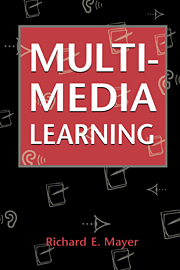Book contents
- Frontmatter
- Contents
- PREFACE
- 1 The Promise of Multimedia Learning
- 2 Multimedia Instructional Messages
- 3 A Cognitive Theory of Multimedia Learning
- 4 Multimedia Principle
- 5 Spatial Contiguity Principle
- 6 Temporal Contiguity Principle
- 7 Coherence Principle
- 8 Modality Principle
- 9 Redundancy Principle
- 10 Individual Differences Principle
- 11 Principles of Multimedia Design
- REFERENCES
- AUTHOR INDEX
- SUBJECT INDEX
3 - A Cognitive Theory of Multimedia Learning
- Frontmatter
- Contents
- PREFACE
- 1 The Promise of Multimedia Learning
- 2 Multimedia Instructional Messages
- 3 A Cognitive Theory of Multimedia Learning
- 4 Multimedia Principle
- 5 Spatial Contiguity Principle
- 6 Temporal Contiguity Principle
- 7 Coherence Principle
- 8 Modality Principle
- 9 Redundancy Principle
- 10 Individual Differences Principle
- 11 Principles of Multimedia Design
- REFERENCES
- AUTHOR INDEX
- SUBJECT INDEX
Summary
Multimedia messages that are designed in light of how the human mind works are more likely to lead to meaningful learning than those that are not. A cognitive theory of multimedia learning assumes that the human information processing system includes dual channels for visual/pictorial and auditory/verbal processing, that each channel has limited capacity for processing, and that active learning entails carrying out a coordinated set of cognitive processes during learning. The five steps in multimedia learning are selecting relevant words from the presented text or narration, selecting relevant images from the presented illustrations, organizing the selected words into a coherent verbal representation, organizing selected images into a coherent visual representation, and integrating the visual and verbal representations and prior knowledge. Processing of pictures occurs mainly in the visual/pictorial channel and processing of spoken words occurs mainly in the auditory/verbal channel, but processing of printed words takes place initially in the visual/pictorial channel and then moves to the auditory/verbal channel.
The goal of this book is to examine principles for the learner-centered design of multimedia learning environments that meet three criteria: (1) intelligibility – the principles are derived from a cognitive theory of multimedia learning; (2) plausibility – the principles are consistent with empirical research on multimedia learning; (3) applicability – the principles can be applied to new multimedia learning situations. The second criterion, plausibility, is covered in chapters 4 through 10, which summarize an empirical research base for multimedia design principles.
- Type
- Chapter
- Information
- Multimedia Learning , pp. 41 - 62Publisher: Cambridge University PressPrint publication year: 2001
- 6
- Cited by



